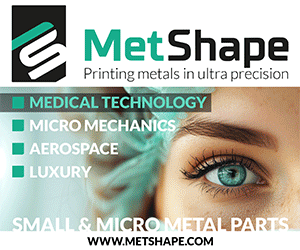High density Metal Injection Moulding (MIM) offers potential for soft magnetic applications
June 11, 2009
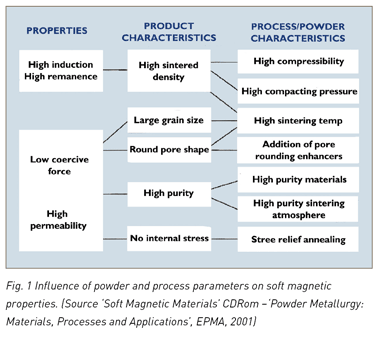
Generally speaking, there are two kinds of materials in a magnetic circuit, known as ‘soft’ or ‘hard’ (permanent) magnetic materials. They are separated by the property that one type, the hard or permanent magnets, once charged – retain their magnetism, whilst the soft magnets lose their magnetic charge once the electrical field or the permanent magnet is removed or reduced.
Modern electric motors are designed with both kinds of magnetic materials within their components.
Press and sinter powder metallurgy (PM) technology has successfully been used for some time to produce ferrous-based PM ‘soft’ magnets because of the ability to produce complex shapes with good magnetic properties.
Soft PM magnetic materials available commercially include pure iron, phosphorus irons with 1% by weight addition of P improving permeability, saturation magnetisation and remanence but with fall in coercivity, nickel irons (normally 50 m/o nickel), cobalt iron (50 m/o cobalt) and silicon irons.
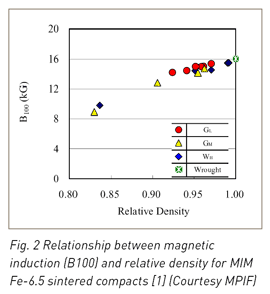 Alloying with Si does not improve magnetic properties significantly, but it does increase the electrical resistance of iron and thus reduces eddy current loss, which is important for soft magnets working at high frequencies – e.g. up to 1000 Hz.
Alloying with Si does not improve magnetic properties significantly, but it does increase the electrical resistance of iron and thus reduces eddy current loss, which is important for soft magnets working at high frequencies – e.g. up to 1000 Hz.
The ferritic stainless steels are also used, especially where corrosion resistance is required, but at the sacrifice of magnetic properties.
High saturation magnetisation and remanence requires a high sintered density in ferrous materials, whilst porosity results in slightly lower permeability and high coercivity than corresponding fully dense (wrought or rolled) soft magnetic materials, and pores should preferably be rounded.
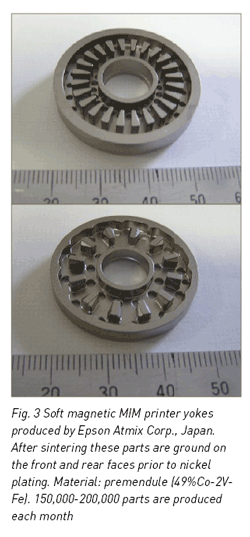 General guidelines for obtaining adequate magnetic properties which can successfully compete with those achieved in fully dense wrought materials are given in Fig. 1. These include use of a powder with the lowest oxygen content, use of a reducing atmosphere, preferably dry hydrogen for sintering, and sintering the alloy at as high a temperature as possible to grow the grains and reduce carbon, nitrogen, oxygen and sulphur to lowest values.
General guidelines for obtaining adequate magnetic properties which can successfully compete with those achieved in fully dense wrought materials are given in Fig. 1. These include use of a powder with the lowest oxygen content, use of a reducing atmosphere, preferably dry hydrogen for sintering, and sintering the alloy at as high a temperature as possible to grow the grains and reduce carbon, nitrogen, oxygen and sulphur to lowest values.
For optimised structure sensitive magnetic properties, most PM parts fabricators compact the powders to the highest possible density and sinter at 1260oC (2300oF) in dry hydrogen for at least 30 minutes.
The use of metal injection moulding
Achieving full density in soft magnets is not feasible with current press and sinter practice, but metal injection moulding has the ability to reach near-full density using fine water or gas atomised powders with low oxygen content. Thus, the higher density parts produced by MIM have the ability to raise magnetic performance of ferrous-based materials for required applications.
Fe-Si and Fe-Ni alloys produced by MIM have already had considerable success in applications such as high-speed dot-matrix printer heads, solenoids for control mechanisms and automatic valves, magnetic amplifiers, relays and small motors.
A recent study using three types of prealloyed Fe-6.5%Si powders – one water atomised with 0.31 oxygen content and mean particle size of 29.8µm, and two gas atomised powders with 0.04-0.09 oxygen and 36-38µm mean particle size (Table 1) – showed that MIM could be successfully used to produce soft magnetic material having >95% relative sintered density [1].
The study reported that higher densities and purity levels in the MIM materials resulted in magnetic induction and maximum permeability values equivalent to wrought materials (Fig.2). Examples of soft magnetic components produced by MIM are shown in Fig. 3.
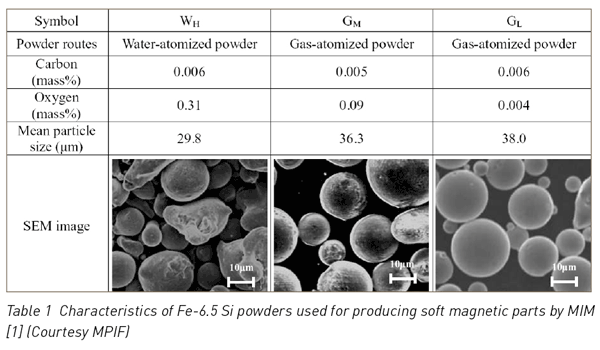
[1] ‘Magnetic Properties of Fe-6.5Si Powder injection Moulded Materials’ by H. Miura, etal. Presented at the 2008 PM World Congress, Washington, June 2008. Published in Proc. 4-144-152
This feature was first published in the March 2009 issue of “Powder Injection Moulding International”. To view contents of the current issue, click here












